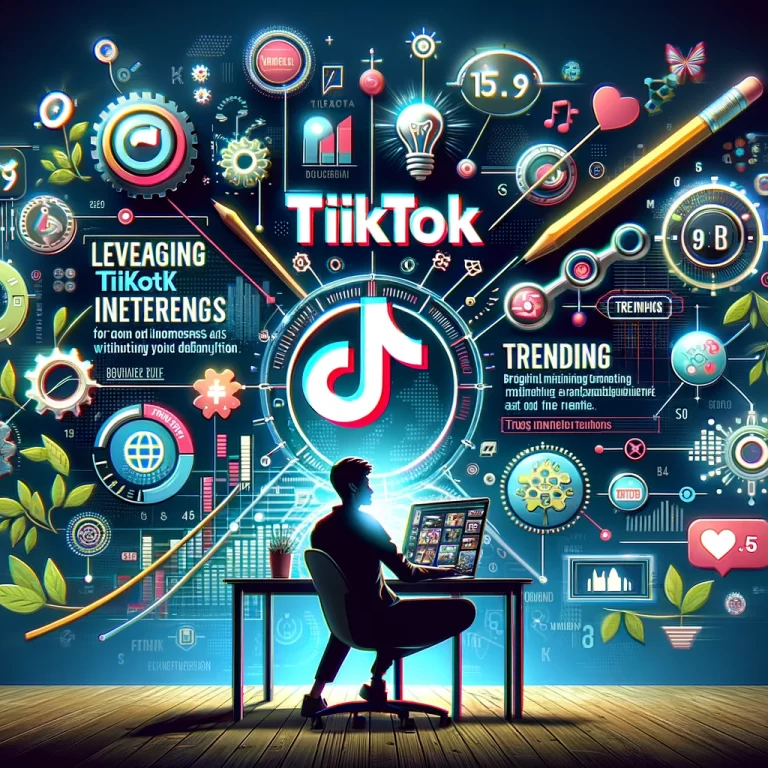In today’s digital age, TikTok has emerged as a powerhouse in the realm of social media, revolutionizing how brands engage with their audience. With over a billion active users worldwide, TikTok offers an unparalleled platform for digital marketing, presenting unique challenges and opportunities for content creators and marketers alike. The key to harnessing this potential lies in understanding and implementing effective TikTok SEO strategies to enhance content visibility and engagement.
TikTok SEO is the art of optimizing your content to ensure it reaches the widest possible audience. This goes beyond mere content creation, involving a deep dive into the algorithmic preferences of the platform, the strategic use of keywords and hashtags, and engaging with the TikTok community in meaningful ways. The goal is to increase your content’s discoverability, thereby maximizing views, likes, shares, and follows.
In this article, we’ll explore the key strategies you need to adopt to optimize your TikTok content for maximum visibility. From understanding TikTok’s algorithm to timing your posts for optimal engagement, these insights are designed to elevate your TikTok presence and ensure your content stands out in a crowded field.
Key Strategies Preview
- Understanding TikTok’s Algorithm: Get to grips with what makes TikTok tick, including how content is ranked and presented to users.
- Keyword Research for TikTok: Uncover the importance of keyword research in making your content discoverable on this platform.
- Optimizing Video Content: Learn how to craft videos that not only capture attention but also encourage higher engagement rates.
- Mastering Hashtags: Discover the role of hashtags in reaching a broader audience and how to select the right ones for your content.
- Engaging with the Community: Find out how interaction with your audience can significantly boost your content’s visibility.
- Timing Your Posts: Understand when to post your content to catch the wave of maximum user engagement.
- Analyzing and Adapting Your Strategy: Learn to use TikTok’s analytics tools to refine and improve your SEO strategy over time.
As we delve into these strategies, we will enhance our discussion with relevant images, infographics, and real-world data and statistics to provide a clearer, more engaging narrative. This approach will not only illuminate the path to TikTok SEO success but also inspire you to innovate and experiment with your content strategy.
Stay tuned as we break down each strategy in detail, offering actionable insights and expert tips to help you maximize your TikTok presence. Whether you’re a brand looking to expand your reach or a content creator aiming to increase your visibility, these strategies are your key to unlocking the full potential of TikTok marketing.

Understanding TikTok’s Algorithm
TikTok has captivated a global audience with its unique blend of entertainment, creativity, and community. At the heart of this platform’s success is its sophisticated algorithm, a marvel of digital engineering designed to match content with viewers in the most engaging way possible. Understanding how this algorithm works is crucial for content creators aiming to maximize their visibility and impact on TikTok.
The Mechanics of TikTok’s Algorithm
TikTok’s algorithm is a complex, dynamic system that determines which videos get showcased to users as they scroll through their “For You” page (FYP). Unlike traditional social platforms that rely heavily on follower networks for content distribution, TikTok prioritizes content relevance and user engagement to ensure a personalized experience for each viewer.
Key Factors Influencing Content Visibility
User Interactions: The algorithm pays close attention to how users interact with content, including the videos they like or share, accounts they follow, comments they post, and content they create. These interactions help TikTok gauge user preferences, making it easier to tailor content recommendations.
Video Information: Details such as captions, sounds, hashtags, and effects used in videos are analyzed to understand content themes and relevance. This information plays a crucial role in categorizing content and aligning it with user interests.
Device and Account Settings: TikTok also considers technical details like device type, language preference, country setting, and device categories to optimize content delivery. This ensures that users see content that’s not only relevant to their interests but also compatible with their device capabilities.
The Significance for Content Creators
For creators, grasping the intricacies of TikTok’s algorithm means unlocking the potential to significantly increase their content’s reach and engagement. It highlights the importance of crafting content that resonates with their target audience, using relevant hashtags, engaging audio, and captivating visuals to catch the algorithm’s attention.
Strategies to Enhance Visibility
- Engage with Trends: Participating in trending challenges and using popular sounds can improve your content’s discoverability.
- Optimize Hashtags: Use a mix of broad and niche hashtags to extend your content’s reach across different audience segments.
- Encourage Interaction: Design content that invites viewers to comment, share, or participate in some way, increasing its appeal to the algorithm.
- Post Consistently: Regular posting can help maintain visibility and keep your audience engaged over time.
Understanding and leveraging TikTok’s algorithm is essential for anyone looking to optimize their content for maximum visibility. By focusing on user interactions, video information, and device/account settings, creators can significantly enhance their chances of appearing on more For You pages. As the digital landscape continues to evolve, staying informed about these mechanisms will be key to success on TikTok and beyond.

Keyword Research for TikTok
In the dynamic world of TikTok, visibility is the currency of success. As the platform continues to grow, standing out becomes increasingly challenging yet more crucial than ever. At the heart of this challenge lies the strategic use of keywords—a fundamental aspect of TikTok SEO that can dramatically enhance your content’s reach. Understanding how to effectively conduct keyword research and integrate these insights into your TikTok strategy is key to unlocking unprecedented levels of engagement and visibility.
The Importance of Keyword Research in TikTok SEO
Keyword research isn’t just about understanding what your audience is searching for; it’s about diving deep into the psyche of TikTok’s diverse user base to anticipate their needs, interests, and the content they’re likely to engage with. By identifying and utilizing the right keywords and hashtags, you can ensure your content connects with the right audience, at the right time, making it a critical component of any successful TikTok marketing strategy.
Tools and Methods for Identifying Trending Keywords and Hashtags on TikTok
To stay ahead in TikTok’s fast-paced environment, leveraging the right tools and methods for keyword research is essential. Here are some strategies to help you uncover trending keywords and hashtags:
- TikTok’s Discover Page: A treasure trove of trending hashtags and popular content, providing immediate insights into what’s capturing the TikTok community’s attention.
- Third-Party Tools: Platforms like TokBoard, TrendTok, and Hashtag Expert for TikTok can offer in-depth analytics on hashtag performance and trending topics.
- Competitor Analysis: Observing the keywords and hashtags used by successful competitors can offer valuable clues to what might work for your content.
- TikTok Analytics: For those with a TikTok Pro account, the analytics section provides data on the performance of your posts and the interests of your audience, helping refine your keyword strategy.
Tips for Integrating Keywords Naturally into Video Titles, Descriptions, and Hashtags
Once you’ve identified your target keywords and hashtags, integrating them naturally into your content is crucial. Here’s how to do it effectively:
- Video Titles: Craft catchy titles that incorporate your main keyword. Ensure it reads naturally and entices users to watch.
- Video Descriptions: Use descriptions to expand on the title, including additional keywords and relevant hashtags. Keep it engaging and informative.
- Hashtag Usage: Combine trending, niche-specific, and branded hashtags to broaden your content’s reach. Limit the number to avoid overcrowding and focus on relevance.
Keyword research is a powerful tool in the TikTok SEO arsenal, capable of propelling your content to new heights of visibility and engagement. By understanding and implementing the strategies outlined above, you can ensure that your content not only reaches but resonates with your target audience, driving growth and success on TikTok.

Optimizing Video Content for TikTok
In the fast-paced world of TikTok, capturing the attention of viewers is both an art and a science. With millions of videos competing for eyeballs, content creators must leverage every tool at their disposal to make their videos stand out. This segment explores proven strategies for creating engaging, high-quality video content that resonates with audiences, emphasizing the pivotal role of the first few seconds and the power of editing features, effects, and music in enhancing video appeal.
Strategies for Creating Engaging and High-Quality Video Content
- Understand Your Audience: Tailor your content to the interests, preferences, and behaviors of your target audience. Use TikTok’s analytics to gain insights into their demographics and content preferences.
- Embrace Authenticity: Authentic content resonates with TikTok users. Share genuine stories, experiences, and emotions to create a real connection with your audience.
- High-Quality Production: While authentic, DIY videos can perform well, paying attention to video quality (clear visuals and audio) can significantly improve engagement.
- Creative Storytelling: Use storytelling to make your videos more compelling. A clear beginning, middle, and end can keep viewers hooked until the last second.
Importance of the First Few Seconds
The first few seconds of your TikTok video are crucial in determining whether viewers will stay or scroll away. These tips can help you make those initial moments count:
- Hook Viewers Immediately: Start with a captivating hook that promises value, entertainment, or both. This could be a bold statement, a surprising visual, or a compelling question.
- Showcase the Best First: Lead with your most engaging or visually appealing content to grab attention right off the bat.
- Preview the Outcome: If applicable, give viewers a glimpse of the video’s end result or the value they’ll gain by watching to the end.
Enhancing Video Appeal with Editing Features, Effects, and Music
TikTok offers a wealth of editing tools and features that can elevate the quality and appeal of your videos:
- Editing Features: Utilize TikTok’s built-in editing tools to trim clips, merge segments, and adjust video speed for dynamic effects.
- Effects and Filters: Experiment with TikTok’s vast array of effects and filters to add flair and mood to your videos. Use them judiciously to complement the content rather than overshadow it.
- Music and Sound: Music can drastically alter the vibe of a video. Select tracks that match the energy and theme of your content. Take advantage of trending sounds to increase discoverability.
Optimizing video content for TikTok requires a blend of creativity, strategic planning, and technical proficiency. By focusing on engaging content creation, maximizing the impact of the first few seconds, and skillfully using TikTok’s editing features, effects, and music, creators can significantly enhance their content’s appeal and visibility. In a platform where trends come and go with lightning speed, staying adaptable and continually refining your approach based on feedback and performance analytics is key to long-term success.

Mastering Hashtags for Greater Reach on TikTok
In the dynamic and crowded world of TikTok, hashtags serve as beacons, guiding users to content that resonates with their interests and preferences. Understanding the role of hashtags and how to strategically employ them can significantly amplify your content’s reach, connecting you with audiences far beyond your current followers. This segment delves into the art of mastering hashtags for greater discoverability on TikTok.
The Role of Hashtags in TikTok Discoverability
Hashtags are not just metadata tags; they are powerful tools for categorization and discovery on TikTok. They help the algorithm understand what your content is about, making it easier to surface your videos to users interested in similar topics. By including relevant hashtags in your posts, you increase the chances of appearing on the For You page (FYP) of potential new followers, thereby enhancing your content’s visibility and engagement.
Choosing the Right Mix of Hashtags
The secret to hashtag success lies in striking the right balance between trending, niche-specific, and branded hashtags. Here’s how to navigate this mix:
Trending Hashtags: Keeping an eye on trending hashtags and incorporating them into your content can boost visibility. These hashtags are often tied to popular challenges, events, or topics, attracting a wide audience.
Niche-Specific Hashtags: To attract viewers with specific interests, include hashtags that are relevant to your content’s niche. This ensures your videos reach an audience more likely to engage with and appreciate your content.
Branded Hashtags: For brands and creators looking to build a cohesive identity on TikTok, creating unique branded hashtags for campaigns can foster community engagement and user-generated content, amplifying reach.
Tips for Creating Unique Branded Hashtags for Campaigns
Keep It Simple and Memorable: Your branded hashtag should be easy to remember and spell, encouraging more users to adopt it in their own posts.
Be Relevant and Specific: Ensure your hashtag directly relates to your brand or campaign, making it easy for users to understand the connection.
Promote Your Hashtag: Integrate your branded hashtag into your TikTok bio, promote it in your videos, and use it across other social media platforms to increase visibility.
Engage with Hashtag Users: Monitor your branded hashtag and engage with users who post content using it. Liking, commenting, and sharing these posts can encourage further participation and spread the word.
Mastering the use of hashtags on TikTok is a crucial skill for anyone looking to enhance their content’s visibility and reach. By carefully selecting a mix of trending, niche-specific, and branded hashtags, you can significantly improve your chances of appearing on the FYP of a broader audience. Furthermore, creating and promoting unique branded hashtags for campaigns can foster a sense of community and brand loyalty, further amplifying your reach on this dynamic platform.

Engaging with the TikTok Community for SEO Benefits
In the ever-evolving world of TikTok, creating content that stands out is only part of the journey to success. The other, equally crucial part is engaging with the TikTok community. This engagement, encompassing likes, comments, and shares, plays a pivotal role in boosting video visibility and, by extension, SEO on the platform. Here, we explore strategies to foster viewer interaction and the undeniable benefits of collaborating with fellow TikTok users and influencers, all under the banner of enhancing your TikTok SEO efforts.
The Importance of Engagement
Engagement metrics such as likes, comments, and shares are more than just vanity numbers; they are indicators of your content’s resonance with the audience. TikTok’s algorithm favors videos with high engagement, interpreting these interactions as signals of quality and relevance, thereby increasing their visibility on users’ For You pages (FYP). Simply put, the more engaged your audience is, the more likely your content is to be promoted by TikTok’s algorithm.
Strategies for Encouraging Viewer Interaction
Craft Compelling Calls-to-Action (CTAs): Whether you’re encouraging viewers to like, comment, or share your video, or prompting them to follow your account, clear and compelling CTAs are key to driving engagement. Tailor your CTAs to the content of each video for the best results.
Use Engaging Captions: Captions are an opportunity to complement your video with context, humor, or questions that provoke thought and invite responses. Well-crafted captions can significantly increase the likelihood of comments and shares.
Respond to Comments: Actively engaging with viewers who comment on your videos fosters a sense of community and can encourage even more interaction, not just with the current video but with future content as well.
Participate in Trends and Challenges: Aligning your content with trending topics, sounds, and challenges on TikTok can increase its visibility and encourage participation from viewers who are exploring these trends.
Benefits of Collaborating with Other TikTok Users and Influencers
Collaborations with other TikTok creators and influencers can catapult your content into new realms of visibility and engagement. These partnerships allow you to:
Reach New Audiences: Collaborating with creators who have a different follower base can introduce your content to a wider audience, increasing your visibility and follower count.
Leverage Cross-Promotion: By featuring in each other’s videos or promoting content across your respective channels, you can mutually benefit from increased exposure.
Boost Credibility: Associating with established TikTok personalities can lend credibility to your content and brand, enhancing your appeal to potential followers.
Engaging with the TikTok community and collaborating with other users are indispensable strategies for maximizing your content’s visibility and improving its SEO on the platform. By fostering genuine interactions and building relationships with other creators, you can enhance your TikTok presence, making your content not just seen, but remembered and valued by a growing audience.

Timing Your TikTok Posts for Maximum Visibility
In the quest for TikTok supremacy, understanding the intricacies of timing can be your secret weapon. The digital landscape of TikTok is governed by algorithms that favor engagement and relevance, making the timing of your posts a crucial factor in maximizing visibility and interaction. This segment delves into the significance of posting times, the tools and analytics available to pinpoint these optimal moments, and how consistency and frequency are key in cultivating a dedicated following.
The Impact of Posting Times on Visibility and Engagement
The timing of your TikTok posts plays a pivotal role in determining their reach and engagement levels. Posting when your target audience is most active increases the likelihood of your content being seen and interacted with, thus boosting its performance in the TikTok algorithm. This enhanced visibility can lead to higher engagement rates, more followers, and greater overall success on the platform.
Leveraging Tools and Analytics
To identify the best times to post for your specific audience, a data-driven approach is essential. TikTok provides creators with analytics tools (available to Pro accounts) that offer insights into your followers’ activity patterns, including when they are most active on the platform. Additionally, third-party tools and services can analyze your engagement data, offering recommendations for the optimal posting schedule tailored to your audience’s habits.
- TikTok Analytics: Dive into the ‘Followers’ tab to understand your audience’s active hours and days.
- Third-Party Scheduling Tools: Platforms like Later, Buffer, and Hootsuite offer analytics and scheduling features to automate and optimize your posting times based on audience engagement data.
The Role of Consistency and Frequency
Consistency and frequency in posting are vital components in building and maintaining a loyal TikTok following. Regular posting keeps your audience engaged and helps establish a predictable pattern, encouraging users to return to your profile in anticipation of new content. It also signals to the TikTok algorithm that you are an active and relevant creator, which can enhance your content’s distribution.
- Consistency: Establish a posting schedule that aligns with your audience’s peak activity times. Whether it’s daily, every other day, or a few times a week, maintaining a consistent cadence can significantly impact your growth on the platform.
- Frequency: While quality should never be sacrificed for quantity, increasing your posting frequency can maximize your visibility and provide more opportunities for engagement.
Mastering the art of timing on TikTok is not an overnight feat but a strategic endeavor that requires analysis, experimentation, and adaptation. By leveraging TikTok’s analytics and third-party tools to determine the best posting times, and committing to a consistent and frequent posting schedule, you can significantly improve your content’s visibility, engagement, and overall success on the platform.

Leveraging TikTok’s Features and Trends for Maximum Visibility
In the fast-paced world of TikTok, trends come and go with lightning speed, and the platform’s features evolve continuously to offer users new ways to create and engage with content. For brands and content creators, staying abreast of these changes and ingeniously integrating them into their content strategy is paramount to maintaining relevance and maximizing visibility. This segment explores how to effectively leverage TikTok’s features and trends, ensuring your brand remains identifiable while riding the wave of trending content.
Staying Up-to-Date with TikTok Features and Trends
TikTok’s dynamic ecosystem is fueled by its ever-changing trends and features, from dance challenges and sound bites to AR filters and hashtag campaigns. Brands that successfully tap into these trends not only boost their visibility but also demonstrate their adaptability and connection with the TikTok community. Keeping your content aligned with these trends requires a proactive approach:
- Regularly Monitor the Discover Page: TikTok’s Discover page is a goldmine of trending hashtags, sounds, and challenges. Regular visits can provide insights into what’s capturing the community’s interest.
- Follow Popular Creators and Influencers: Influencers often lead the charge on trends. Observing their content can offer early signals on what’s likely to take off next.
- Utilize TikTok Analytics: Insights from your own content can highlight trends resonating with your audience, guiding your strategy on which trends to adopt.
Creatively Integrating Trends Without Losing Brand Identity
While jumping on trends can increase engagement, it’s crucial that this is done in a way that doesn’t dilute your brand’s identity. Here’s how to maintain this balance:
- Adapt Trends to Fit Your Brand Voice: Customize trends to reflect your brand’s unique voice and values. This might mean putting a distinctive twist on a popular challenge or using trending sounds in a way that aligns with your brand’s messaging.
- Selective Trend Participation: Not all trends will fit your brand. Select those that resonate with your identity and audience, ensuring a natural integration into your content strategy.
- Create Branded Hashtags: While participating in trending hashtags, also create and promote your own branded hashtags to tie trending content back to your brand.
Examples of Successful Brand Strategies on TikTok
Many brands have harnessed TikTok trends to amplify their visibility and engagement while staying true to their identity. For instance:
- Chipotle’s #GuacDance Challenge: Leveraging the love for avocados, Chipotle created a branded challenge that became one of TikTok’s highest-performing branded challenges during its run.
- Nike’s Collaborative Efforts with Influencers: Nike often collaborates with influencers on TikTok, creating trend-based content that highlights their products while engaging with the platform’s trend culture.
TikTok offers a unique platform for brands to engage with a vast and diverse audience through creative and trend-driven content. By staying informed about the latest TikTok trends and features, creatively integrating these elements into your content, and maintaining your brand’s identity, you can significantly enhance your visibility and engagement on the platform. Remember, the key to success on TikTok lies in blending trend participation with authenticity, ensuring your brand stands out in the ever-evolving digital landscape.

Analyzing and Adapting Your TikTok SEO Strategy
In the ever-evolving landscape of TikTok, where content trends can change with the wind, the key to sustained visibility and engagement lies not just in the content you create but in how you analyze and adapt your strategy over time. Leveraging TikTok analytics provides invaluable insights into the performance of your content, allowing you to fine-tune your approach for maximum impact. This guide will delve into using TikTok analytics effectively, understanding key metrics, and applying these insights to refine your TikTok SEO strategy.
Using TikTok Analytics to Track Performance
TikTok’s built-in analytics feature offers a comprehensive overview of how your content performs on the platform. Accessible to users with Pro accounts, it provides data on viewer demographics, engagement rates, and much more. Regularly reviewing these analytics is crucial for identifying what works, what doesn’t, and where there’s room for improvement.
Key Metrics to Monitor
- Video Views: The total number of times your videos have been watched. High view counts indicate content that resonates with a broad audience.
- Engagement Rates: Including likes, comments, and shares. These metrics are vital signs of how interactive and appealing your content is to viewers.
- Follower Growth: Tracks the increase in your follower count, offering insights into how your content is attracting new audiences.
- Watch Time: The average time viewers spend watching your videos. Longer watch times suggest more engaging or compelling content.
- Traffic Source Types: Where your views are coming from, whether it’s the For You page, following feed, or external sources. This helps you understand how discoverable your content is across different channels.
Interpreting the Data
Analyzing these metrics allows you to gauge the health of your content strategy on TikTok. For instance, a high number of views from the For You page suggests that your content is well-optimized for TikTok’s algorithm, while engagement rates can tell you how much your content resonates with viewers.
Tips for Refining Your TikTok SEO Strategy
- Optimize Posting Times: Use analytics to determine when your audience is most active and schedule your posts accordingly to maximize reach and engagement.
- Experiment with Content Types: If certain videos perform better than others, consider producing more content in that style or format to engage your audience further.
- Adjust Your Hashtag Strategy: Analyze which hashtags bring the most visibility to your content and refine your hashtag usage based on these insights.
- Engage with Your Audience: Analytics can reveal which types of comments and interactions are most common. Use this feedback to tailor your content and engage more effectively with your audience.
- Monitor Trends: Keep an eye on the performance of content related to trending topics or sounds and adapt your strategy to incorporate these trends when they align with your brand identity.
By closely monitoring your TikTok analytics and adapting your strategy based on these insights, you can significantly enhance your content’s visibility and engagement on the platform. Remember, the digital landscape is constantly shifting—what works today may not work tomorrow. Therefore, staying agile, experimenting with new approaches, and always being ready to pivot based on data will set you up for long-term success on TikTok.

Conclusion: Maximizing Visibility and Engagement on TikTok
Recap of TikTok Content Optimization
The journey through TikTok SEO is an enlightening path towards understanding how to make your content not only visible but engaging and impactful on one of the world’s most dynamic social media platforms. We’ve explored the intricacies of TikTok’s algorithm, the power of keyword research, the art of creating engaging video content, and the strategic use of hashtags, among other tactics. Each of these elements plays a crucial role in enhancing your content’s ability to reach a wider audience and engage them effectively.
The Value of Experimentation
One of the key takeaways from this exploration is the importance of experimentation. TikTok’s landscape is ever-changing, with trends rising and falling with swift transitions. What works today may not work tomorrow, and thus, the willingness to try new strategies, adapt your content, and even pivot your approach based on performance analytics is vital. This iterative process of testing, learning, and optimizing is what will keep your content fresh and your audience engaged.
Staying Informed and Adaptable
The evolving nature of TikTok SEO underscores the necessity of staying up-to-date with platform updates and changes. TikTok continuously introduces new features, adjusts its algorithm, and shifts user preferences. Staying informed about these changes allows you to adjust your strategies in real-time, ensuring your content remains relevant and visible.
Furthermore, engaging with the TikTok community, leveraging the platform’s features and trends, and continuously analyzing and adapting your strategy based on performance data will enable you to maintain a strong presence on TikTok. Remember, success on this platform is not just about being seen; it’s about connecting and resonating with your audience in meaningful ways.
Final Thoughts
As we wrap up this journey through TikTok SEO, it’s clear that the key to maximizing visibility and engagement lies in a balanced combination of strategic planning, creative content creation, and agile response to analytics and trends. By embedding these principles into your TikTok strategy, you embrace the full potential of your content to captivate and grow your audience on TikTok.

As we conclude our comprehensive exploration of optimizing TikTok content for maximum visibility, we turn to you, our valued readers, to join the conversation. Your experiences, trials, and triumphs in navigating the vibrant world of TikTok SEO hold the power to inspire and educate. Here’s how you can contribute to this ever-evolving dialogue:
Share Your TikTok SEO Tips and Successes
Have you discovered a unique hashtag strategy that increased your video views overnight? Did a particular type of content resonate with your audience in unexpected ways? Perhaps you’ve cracked the code on the best time to post on TikTok for your specific niche. Whatever your success story or insightful tip, we invite you to share it in the comments below. Your contribution could be the beacon that guides fellow creators toward their TikTok aspirations.
Stay Connected for Cutting-Edge Digital Marketing Insights
The landscape of digital marketing is in constant flux, with TikTok at the forefront of social media innovation. To stay abreast of the latest trends, strategies, and updates in TikTok SEO and beyond, we encourage you to subscribe or follow “WWM Digital”. Our commitment is to provide you with actionable insights, in-depth analyses, and timely advice to help you navigate the digital marketing world with confidence and creativity.

